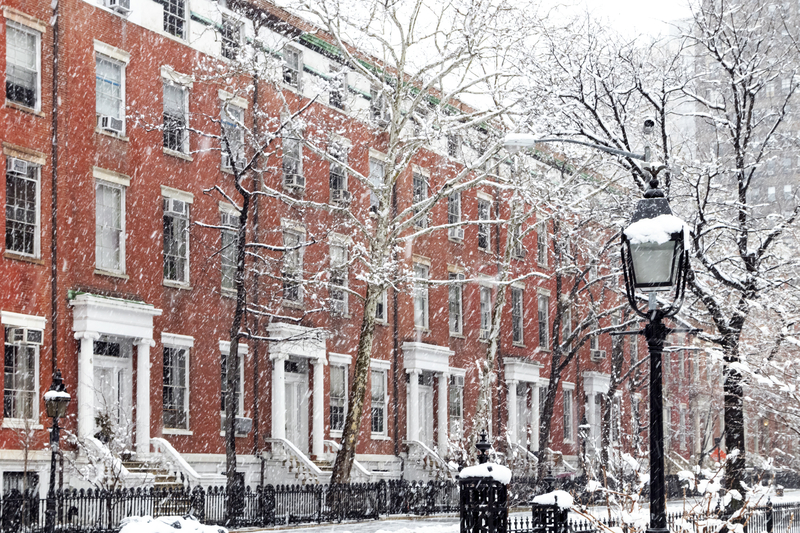Eier noen få kvadratmeter inn New York City er et ønske for de fleste av dere (og for oss). Så når denne eiendommen i NYC er en rekkehus, disse rekkehusene med uforlignelig cachet i de eksklusive nabolagene i byen når vi kremen av avlingen, toppen av toppen. Kjøpe rekkehus er absolutt det beste som kan skje deg i New York, og vi forteller deg hvordan du gjør det.
Hva du trenger å vite før du kjøper et rekkehus i New York City
Det grunnleggende
EN rekkehus er en privat hus hvor minst én vegg deles med en annen bolig. Rekkehus er ganske sjelden i New York eiendomsmarkedet og står for knapt 2% av boligtransaksjoner. Likevel er denne typen eiendom ofte suveren, og noe av det er en del av NYCs eiendomsarv og historie. Historiske detaljer, hager, privatliv, mange soverom og bad ... I en overfylt by som New York hvor boliger er ofte trangt, bor i et rekkehus er en luksus som du snart ikke vil kunne leve uten.
Størrelsen betyr noe!
Faktisk er rekkehus i New York beskrevet i form av bredde og dybde. Når det gjelder bredde, varierer rekkehus fra 13 til 25 fot (3,9 m til 7,62 m), og de fleste rekkehus bygges innenfor en rekkevidde på 17 til 20 fot (4,26 m til 6 m). De er like brede som størrelsen på tomten deres, som betyr størrelsen på tomten som eiendommen ligger på. Når det gjelder dybde, varierer dimensjonene betydelig og det er ofte en utvidelse på en eller flere etasjer som gjør den nøyaktige størrelsen vanskelig å bestemme med presisjon uten hjelp fra en fagmann. Mange rekkehus har også uterom, foran og bak i huset. Generelt, i de fleste boligområder, minimum bakgårdsdybde er minst 30 fot (9,1 m).
Som du kan se, er større rekkehus, jo mer verdifullt er det fordi jo mer luft og lys, jo bedre sirkulasjon mellom rommene. Større og kortere rom er også lettere å ordne enn lengre og smale rom.
Bor i rekkehus
Eieren av et rekkehus i New York er ansvarlig for å betale alle eiendomsskatter , vedlikehold og reparasjoner på eiendommen, i motsetning til en andelsbolig eller et sameie, men det kreves ingen månedlig betaling for bygningsforvaltning. Det er ingen godkjenning fra styret for kjøp eller salg av slik eiendom. Vær også oppmerksom på at salget av eiendommen kan overføres til enhver tredjepart uten forhåndsgodkjenning fra andre enn eieren.
Skattesatsene fastsettes årlig av NYC Council basert på eiendomsklassen. Klasse 1 inkluderer en til tre familieboliger og klasse 2 inkluderer alle andre boligeiendommer. Denne satsen brukes deretter på den takserte verdien av eiendommene som er estimert av Institutt for finans.
Nabolag for å finne et rekkehus å kjøpe i NYC
Det finnes rekkehus å kjøpe på nesten alle områder av New York City, men noen er bemerkelsesverdige, når det gjelder deres geografisk plassering og deres prestisjerenovering. Således, i Upper West Side, blokken mellom Central Park West og Columbus som historisk sett hadde det dyreste salget i 1970. I Upper East Side, det er nær 5th Avenue, hvor den dyreste blokken ligger mellom 70th og 71st East. I Chelsea distrikt, de vakreste rekkehusene finnes i 21st og 22nd streets West, mellom 10th og 11th avenue.
Hvor mye koster et rekkehus i NYC?
Prisen på et rekkehus bestemmes av en rekke variabler, inkludert bygnings- og tomtestørrelse , plassering og tilstand . Fra et nabolag til et annet, noen ganger fra en gate til en annen, kan prisen svinge betydelig . I tillegg er nærmiljøet veldig viktig og man må se på husene bak rekkehuset, de på sidene og den foran. De dyrere rekkehusene ligger i blokker med rekkehusrekker på begge sider av gaten. Ellers er det en brannstasjon, en polititjeneste eller en skole i nærheten eller verre, motsatt vil prisene være lavere på grunn av støy og trafikk. Til slutt bør du vite at hvis prisene på rekkehus på Manhattan generelt starter på flere millioner dollar, er de ofte billigere per kvadratmeter enn leiligheter. Og, i motsetning til en co-op , er det ingen likviditetskrav pålagt kjøperen etter avslutningen (annet enn de som kreves av utlåner).
